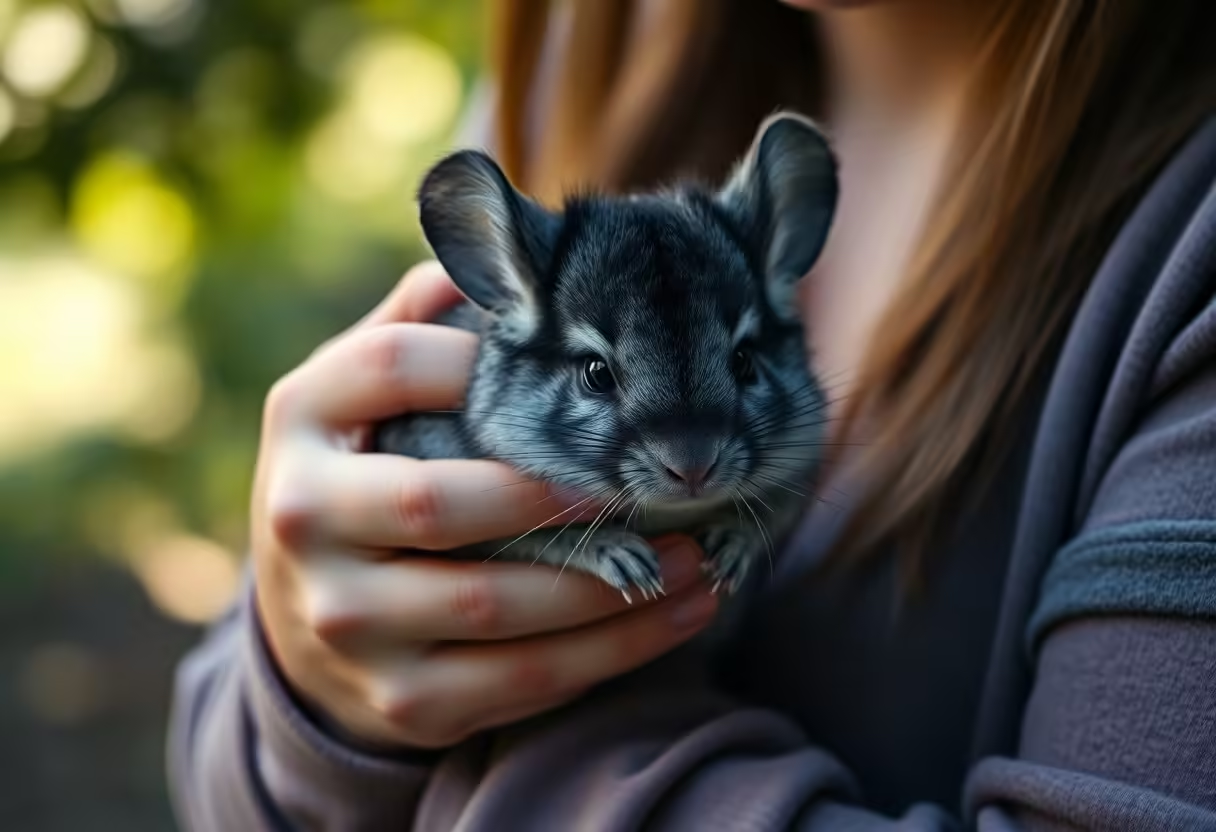Chinchillas are quick, agile pets with delicate bones and a tendency to startle easily, making them challenging to handle for both new and experienced owners. Safe handling requires understanding a chinchilla’s natural instincts and using the right techniques to reduce stress and prevent injury. This guide provides practical steps for building trust, creating a safe environment, and using effective methods for catching and holding your chinchilla comfortably.
Key Takeaways
- Approach slowly and calmly: Avoid sudden movements or loud noises, which can startle your chinchilla and make handling more difficult.
- Use a two-handed grip: Support their body from underneath while holding gently to keep them secure.
- Set up a safe environment: Block off hiding spots and ensure the room is free of hazards before attempting to catch or handle your pet.
- Trust-building is key: Daily interaction and positive reinforcement make handling less stressful over time.
- Be prepared with the right tools: Use a soft towel, proper carrier, and treats to facilitate calm and safe handling.

Understanding Chinchilla Behavior and Instincts
Chinchillas are prey animals with cautious, skittish natures, often avoiding direct handling. Knowing their behavioral tendencies will help you handle them calmly and effectively.
Flight Response Mechanisms
Chinchillas have powerful hind legs that allow them to leap up to six feet when frightened. They may also release fur in a “fur slip” if they feel threatened. Approach from the front and move calmly to avoid triggering these flight responses.
Social Temperament and Trust Building
Chinchillas are social creatures that can bond with their owners over time. Each has a unique personality, so trust-building requires patience and consistent, gentle interactions. Allow your chinchilla to approach on its own terms to gradually reduce stress and foster a positive relationship.

Setting Up the Right Environment for Safe Handling
Before you attempt to catch or handle your chinchilla, create a safe, controlled space to reduce stress and prevent injuries.
Room Preparation
- Clear Hazards: Remove electrical cords, small objects, or toxic plants that could pose a risk.
- Block Hiding Spots: Use barriers like cardboard or pet gates to prevent access to tight spaces or under furniture.
- Close Doors and Windows: Ensure all escape routes are sealed, and the room has gentle ventilation without drafts.
Optimal Room Conditions
| Condition | Optimal Range |
|---|---|
| Temperature | 60-70°F (15-21°C) |
| Humidity | 40-60% |
| Lighting | Moderate, indirect light |
| Noise Level | Minimal background noise |
| Time of Day | Early evening (active hours) |
Avoid direct sunlight or loud sounds, as these can easily stress your chinchilla. A calm, cool environment helps them feel secure during handling.
Essential Equipment for Safe Handling
Using the right tools and protective gear helps make handling safer and more comfortable for you and your chinchilla.
Handling Tools
- Catching Net: A small animal-specific net with soft mesh for quick capture in emergencies.
- Transport Carrier: Use a secure, ventilated carrier to safely move your chinchilla from one area to another.
- Soft Towel: Useful for gently containing your chinchilla, especially if they’re nervous or quick-moving.
Safety Gear
- Thick Gloves: Protect your hands from bites and scratches without reducing your dexterity.
- Protective Eyewear: Shields against dust or debris during handling.
- Long-Sleeved Shirt: Prevents scratches on your arms if your chinchilla tries to squirm away.
Building Trust with Your Chinchilla
Building a trust-based relationship with your chinchilla makes handling easier and less stressful over time.
Initial Contact Methods
- Sit Near the Cage: Spend 15–20 minutes daily near your chinchilla’s cage, allowing it to get used to your presence.
- Hand Inside the Cage: Without touching, place your hand near your chinchilla to let it sniff and investigate at its own pace.
- Soft Speech: Speak quietly to help your chinchilla become familiar with your voice, which can be comforting over time.
Positive Reinforcement Strategies
- Offer Treats: Use approved, low-sugar treats to encourage your chinchilla to approach. Offer treats only when your pet is calm to reinforce relaxed behavior.
- Reward Calm Interactions: If your chinchilla willingly climbs onto your hand or approaches you, reward it with a treat to create positive associations with handling.

Methods for Catching and Handling a Chinchilla
Hands-Free Methods
- Using a Carrier or Box: Place the carrier in the chinchilla’s cage or near it, and use treats to encourage them to enter on their own.
- Luring with a Dust Bath: Place a dust bath near the chinchilla; they may feel comfortable enough to enter, making it easier to transport them back to their cage.
- Guiding with a Tunnel: Many chinchillas feel safer in a tunnel. Use a small, enclosed tube to gently guide them in, then carry the tube carefully to avoid sudden movements.
Direct Handling Techniques
- The Scoop Method: Support the chinchilla’s body from underneath with one hand while gently cupping its chest with the other. This two-handed method helps them feel secure and prevents them from wriggling.
- Avoid Restrictive Holds: Chinchillas panic if restrained too tightly. Hold them close to your body but avoid wrapping your hands too tightly around their body.
Common Mistakes to Avoid
Avoiding certain handling mistakes can prevent unnecessary stress or injury:
- Grabbing from Above: This can trigger a chinchilla’s fear response, as it mimics predator behavior.
- Restraining Too Tightly: Tight holds can make chinchillas panic, leading to squirming or biting.
- Forcing Interaction: Allow your chinchilla to set the pace, as forcing them can damage the trust you’ve built.
Emergency Handling Techniques
In urgent situations, you may need to catch your chinchilla quickly. These techniques should be used sparingly, as they can be more stressful for the chinchilla.
Towel Method (Last Resort)
- Gently Cover with a Towel: Approach your chinchilla slowly and cover it with a soft towel, allowing you to contain it safely.
- Avoid Constriction: Keep the towel loose and only use it to guide the chinchilla into a secure carrier or back into its cage.
Humane Trap
- Set Up a Live Trap: Use a humane live trap with treats or Timothy hay as bait, especially if your chinchilla has hidden somewhere difficult to reach.
- Check Regularly: Once set, check the trap frequently to minimize the time your chinchilla is contained.
Preventing Future Escapes
To avoid repeated escapes, secure your chinchilla’s environment with escape-proof measures.
- Inspect the Cage: Check for weak latches, chewable areas, or gaps where a chinchilla might squeeze through.
- Routine Interaction: Regular handling and positive interaction reduce the chance of your chinchilla attempting to escape out of fear.
FAQ
Q: What is the best time of day to catch my chinchilla?
A: Chinchillas are most alert and receptive during their active hours—early morning or evening. Avoid handling them in the middle of the day when they’re typically sleeping.
Q: How should I properly pick up my chinchilla?
A: Place one hand under the chinchilla’s chest and support their hindquarters with the other. Avoid grabbing by the tail or limbs, which can lead to injury.
Q: What signs indicate that my chinchilla is stressed while being handled?
A: Signs of stress include rapid breathing, fur slipping, biting, or attempting to escape. Return your chinchilla to its cage if these behaviors occur.
Q: How can I train my chinchilla to be more comfortable with handling?
A: Start by offering treats and letting them approach your hand. Gradually increase handling time, rewarding calm behavior to build trust.
Q: What safety precautions should I take when handling my chinchilla outside their cage?
A: Handle in a secure, enclosed space free of escape routes or hazards. Keep a firm but gentle grip and stay low to the ground in case of sudden movements.
Long-Term Success Strategies for Handling
Establishing a daily handling routine can make a significant difference in reducing stress over time.
- Consistency: Set a regular time each day for handling to create a sense of routine.
- Gradual Progression: Start with short handling sessions and gradually increase duration as your chinchilla becomes more comfortable.
- Build Trust Through Positive Reinforcement: Regularly use treats and gentle interaction to strengthen your bond.
Conclusion
By following these handling techniques and building a trusting relationship with your chinchilla, you can create a more positive experience for both you and your pet. Patience, consistency, and gentle handling will ensure that catching and handling your chinchilla becomes a routine and stress-free part of your day.
